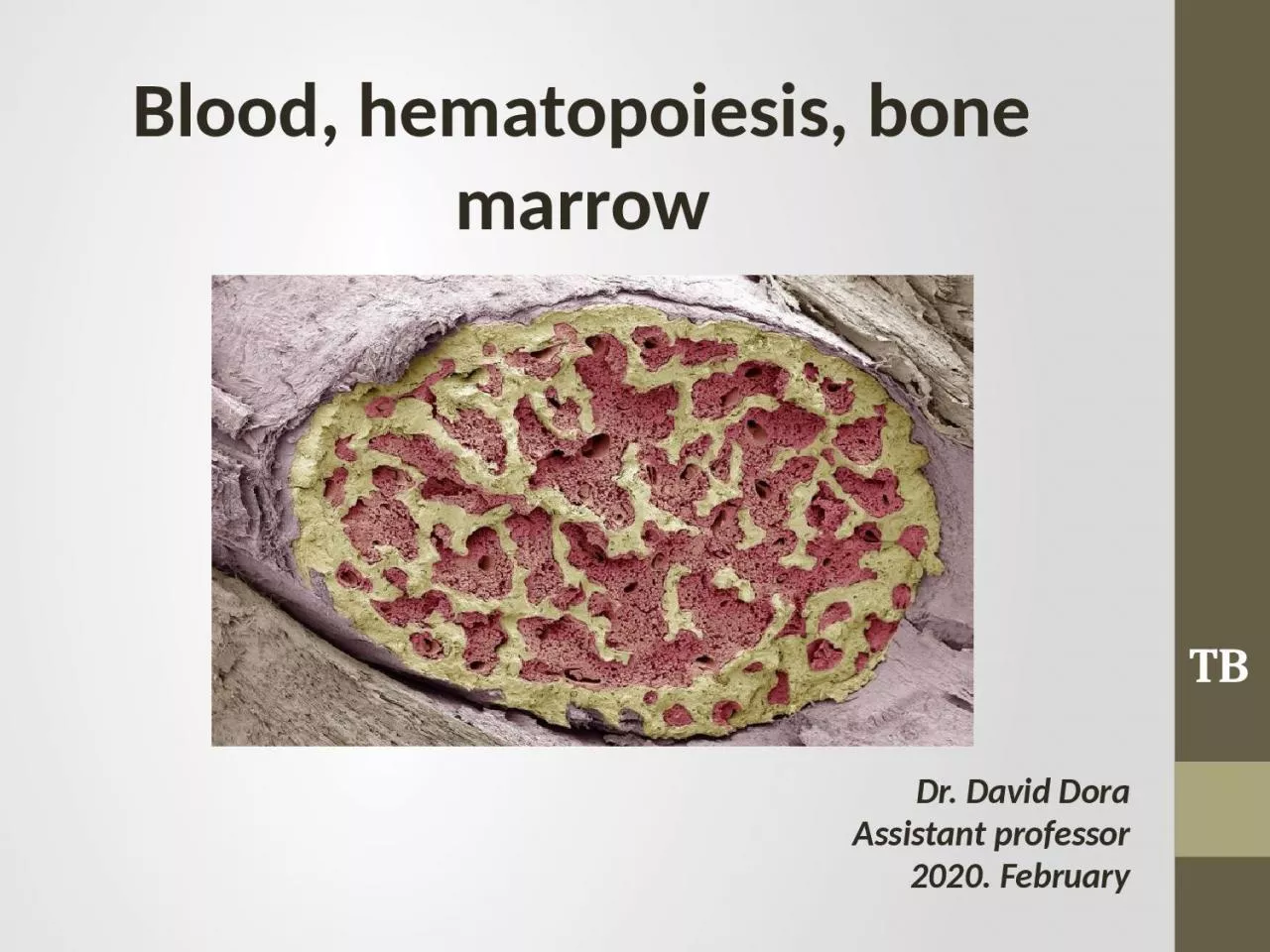

Dr David Dora Assistant professor 2020 February TB Blood primary functions Suppl ies oxygen for tissues bound to hemoglobin in red blood cells RBC Suppl ID: 927378
Download Presentation The PPT/PDF document "Blood, hematopoiesis, bone marrow" is the property of its rightful owner. Permission is granted to download and print the materials on this web site for personal, non-commercial use only, and to display it on your personal computer provided you do not modify the materials and that you retain all copyright notices contained in the materials. By downloading content from our website, you accept the terms of this agreement.
Slide1
Blood, hematopoiesis, bone marrow
Dr. David DoraAssistant professor2020. February
TB
Slide2Bloodprimary functions
Supplies oxygen for tissues
(bound to hemoglobin, in red blood cells, (RBC))Suppl
ies
nutrients
such as glucose, amino acids, and fatty acids (dissolved in the blood or bound to plasma
proteins
)
Removal of waste
such as carbon dioxide, urea, and lactic acid
Immunological
functions, including circulation of white blood cells, and detection of foreign material by antibodies
Coagulation
, blood clotting:
part
of the body's self-repair
mechanism
Messenger
function,
including the transport of hormones and
a variety of molecular mediators
Regulation of body
pH
Regulation of core body
temperature
Slide3Composition of blood
CELLULAR COMPONENTS
Red blood cells (erythrocytes)99
% of the cells
Gas transport (O2, CO2
)
White blood cells
(leukocytes)Internal defensePlatelets(thrombocytes)blood clotting
PLASMA55 % of the blood’s volumeWaterElectrolytesProteins:Albumin, fibrinogen, globulinsTransported molecules:Nutrients, vitamins, hormones, trace elements, metabolic products, fatty substances
Plasma without fibrinogen is called serum
Slide4Slide5Slide6Blood smear and May-Grünwald Giemsa staining
to study the morphology of blood cells
Slide7Red blood cells (erythrocytes)
Slide8Red blood cells (erythrocytes)
no cell nucleus
Erythrocytes are flexible, biconcave discs that are packed with hemoglobin (special cytoskeleton with
actin
,
spectrin, ankyrin
molecules
high elasticity)O2 and CO2 transportlifespan: 120 days, processed in the spleen and in the liver (iron: stored, reused)Covered by extensive glycocalixABO blood groups
Slide9Hemoglobin
Almost 99% of the O
2
in human blood
is
transported
as oxyhemoglobin (HbO2)Hemoglobin is a group of compounds that have an iron-porphyrin (heme) group bound to a protein (globin)
Slide10Platelets (thrombocytes)
cytoplasm fragments which derives from megakaryocytes (giant cells in the bone marrow)
lifespan: 5-10 days250-300 000/ml2-3 µ
m
blood
clotting: forming the platelet-plug
Slide11TB
Slide12Slide13White blood cells (leukocytes)
Granulocytes(polymorphonuclear leukocytes)
PMNSneutrophils (neutrophil granulocytes)
eosinophils (eosinophil granulocytes)
basophils (basophil granulocytes)
Agranulocytes
MPS
Monocytes
LymphocytesB-cellsT-cellsNK-cells
Slide14Neutrophil granulocyte
size: 10-15 µm
segmented nucleus (3-5 lobes),
small granules in the
cytoplasm (neutrophil=no colour)
60-70% of white blood cells
Main function: phagocytosis
Innate immune system
Slide15TB
Slide16Eosinophil granulocyte
size: 10-15 µ
mbilobed nucleuseosinophilic
granules containing histamin,
cr
y
stals can be detected by
EM1-6% of white blood cellsIn allergic reactions inactivation of excess histamine (from mast cells or basophils)Anti-parasitic defense (Major basic protein, MBP)
Slide17Basophil granulocyte
size: 10-15 µm
bilobed nucleus (not seen because of the granules)many, large, basophil cytoplasmic granules (heparin, histamine).
0-1% of white blood cells
effector cells in allergy, immediate hypersensitivity
Slide18TB
Slide19Monocytes
size: 15-20 µm
(largest WBC!)ovale or kidney-shaped n
u
cleus, numerous lysosomes in the cytoplasm
precursors of tissue
macrophages
2-6 % of white blood cellscoordination of cellular and humoral immune response, phagocytosis
Slide20TB
Slide21Lymphocytes
size: 8-10 µm
round-shaped nucleus, organellum rich citoplasm20-40 % of white blood cells
cells of the specific (humoral and cellular)
immunity
Inactive B-cells, T-cells and NK-cells are indiscernable on MGG staining
Slide22TB
Slide23Hematopoiesis and the bone marrow
What are stem cells? Stem cells are unspecialized cells that have two defining properties: the ability to differentiate into other cells and the ability to self-regenerate.
The three broad categories of stem cells are: Embryonic stem cells, derived from blastocysts,Adult
stem cells, which are found in adult
tissues
Fetal
stem cells, which are found in the umbilical cord.Stem cells of the adult tissues are tissue specific (hemopoetic, nervous, muscle stem cells)
Slide24Primitive, yolk sac
Definitive, hepatolienal
Definitive, myeloid, BM
Slide25The hemangioblast
vasculogenesis and hematopoiesis
Yolk sac primitive hematopoesis
Slide26Intraembryonic
hematopoesisAGM region
Slide27Bone marrow
Red bone marrow (spongy bone, long bone)stroma (reticulum cells, adipocytes, macrophages)cells of hematopoesis
sinusoid (discontinuous endothel)Megakaryocytes
Defragmenting thrombocytes
Slide28TB
Slide29Slide30Diapedesis, TEM image
Slide31Slide32Slide33Hematopoiesis
TB
Slide34Thank you for your attention!
Dr. David Dora
2020. February